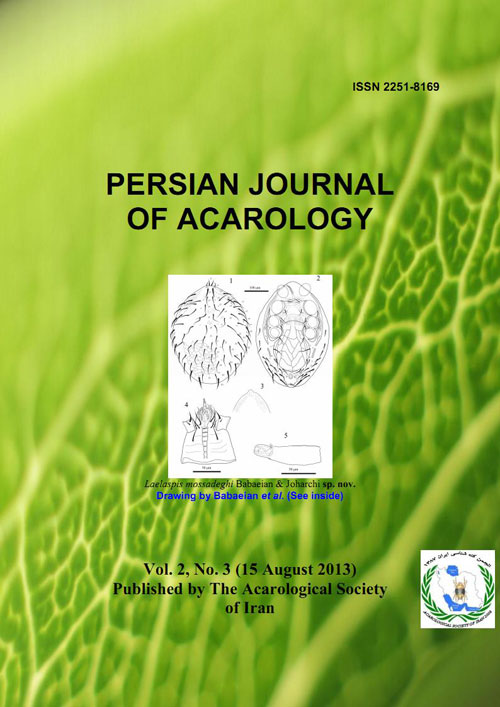فهرست مطالب

Persian Journal of Acarology
Volume:2 Issue: 3, Summer 2013
- تاریخ انتشار: 1392/06/28
- تعداد عناوین: 11
-
-
Page 341Larvae of Leptus (Leptus) holgeri Haitlinger, 1999 were collected from undetermined Orthoptera (Acrididae) for the first time from Vietnam. This paper presents new morphological and meristic data for the species. All Leptus species found on Orthoptera are mentioned and their distribution are given.Keywords: Parasitengona, Trombidiformes, ectoparasites, Orthoptera
-
Page 353A new species of melittiphine laelapid mites, Laelaspis mossadeghi Babaeian & Joharchi sp. nov. associated with Messor sp. and Tapinoma sp. (Hymenoptera: Formicidae) is described and illustrated from Iran.Keywords: Acari, Taxonomy, Mesostigmata, Laelaspis, ants, Iran
-
Page 361New morphological data on Strunkobia pamirica Livschitz & Mitrofanov is provided from materials collected from Euphorbia sp. (Euphorbiaceae) and a new host plant, Artemisia aucheri (Asteraceae) in Iran. This species is a new record to the spider mite fauna of Iran.Keywords: Strunkobia, host record, new record, Kerman
-
Page 369Collects of Phytoseiidae species of the genus Typhlodromus Scheuten have been carried out in some regions of Western and NorthWestern Iran from 20082011. This paper presents the redescription of six species belonging to two subgenera Typhlodromus (Anthoseius) De Leon and Typhlodromus (Typhlodromus) Scheuten (each with three species, respectively): T. (A.) bagdasarjani Wainstein & Arutunjan, T. (A.) kerkirae Swirski & Ragusa, T. (A.) khosrovensis Arutunjan, T. (T.) phialatus AthiasHenriot, T. (T.) leptodactylus Wainstein and T. (T.) tubifer Wainstein. It is the first record of T. (T.) phialatus AthiasHenriot for the Iranian phytoseiid fauna. This paper also provides an identification key of the species of the genus Typhlodromus in Iran.Keywords: predatory mite, Anthoseius, Typhlodromus, new record, Iran
-
Page 389This catalog comprises 56 genera and 266 species of mite names of superfamilies Raphignathoidea and Tetranychoidea recorded from Iran at the end of January, 2013. Data on the mite distributions and habitats based on the published information are included. Remarks about the incorrect reports and nomen nudum species are also presented.Keywords: Checklist, mite, habitat, distribution, Iran
-
Page 475A new caligonellid mite species of the genus Neognathus, N. rijabicus sp. nov., is described and illustrated from females collected in wheat litter in Kermanshah province, Iran.Keywords: Caligonellidae, mite, adult, female, Kermanshah province
-
Page 481A new species of the genus Raphignathus Dugés (Acari: Raphignathidae), R. khorramabadensis Bagheri sp. nov. is described and illustrated from soil in Bisheh region, suburb of Khorramabad in Lorestan province, western Iran.Keywords: Trombidiformes, Raphignathina, Khorramabad, Lorestan province
-
Page 487Six cryptognathid mites were collected from Kütahya Province. Of these, three species belong to the genus Cryptognathus Kramer, 1879 and three species to the genus Favognathus Luxton, 1973. A new species Cryptoganathus kutahyaensis sp. nov., and the male of Favognathus cucurbita Berlese, 1917, from Turkey, are described and illustrated. Keys to all the species of the genus Cryptognathus and the Favognathus species of the Kütahya Province are provided.Keywords: Acari, Cryptognathidae, Cryptognathus kutahyaensis sp. nov., new species, Turkey
-
Page 503The taxonomic status of ticks in the genus Hyalomma, as prominent vectors of domestic animal and human pathogen agents as well as hematophagous parasites of all terrestrial animals has a problematic history due to variability. The present paper is based on our observations on the Iranian Hyalomma species during 2009 to 2013. In this study, for nine Hyalomma species including H. aegyptium, H. anatolicum, H. asiaticum, H. detritum, H. dromedarii, H. excavatum, H. marginatum, H. rufipes and H. schulzei, morphologic characteristics and some notes on their variability, biology and distribution are presented. In this paper, diagnoses, host information, distribution data, illustrations of adult males and a taxonomic key to the native Hyalomma species of Iran are provided to facilitate their identification.Keywords: Hyalomma, identification key, Iran, taxonomy, morphological characteristcs
-
Page 531Tetranychus urticae Koch is one of the most injurious tetranychid mites on greenhouse roses. Typhlodromus bagdasarjani Wainstein & Arutunjan is a generalist indigenous phytoseiid mite with a wide distribution in Iran and frequently reported from plants infested by tetranychids. In this research, the preference of protonymph, deutonymph and adult of T. bagdasarjani on different stages of T. urticae was studied under laboratory conditions (25 ± 1°C, 75 ± 5% RH and 16L: 8D h. of photoperiod). The experiment was carried out on rose leaf square (blarodje variety). The preference index for each predator stage was calculated with Manlys β index. Comparison of the mean preference index for protonymph (F = 135.61; df = 3, 84; PKeywords: Prey, predator, Rosa hybrida L. cv. blarodje, Rosaceae


